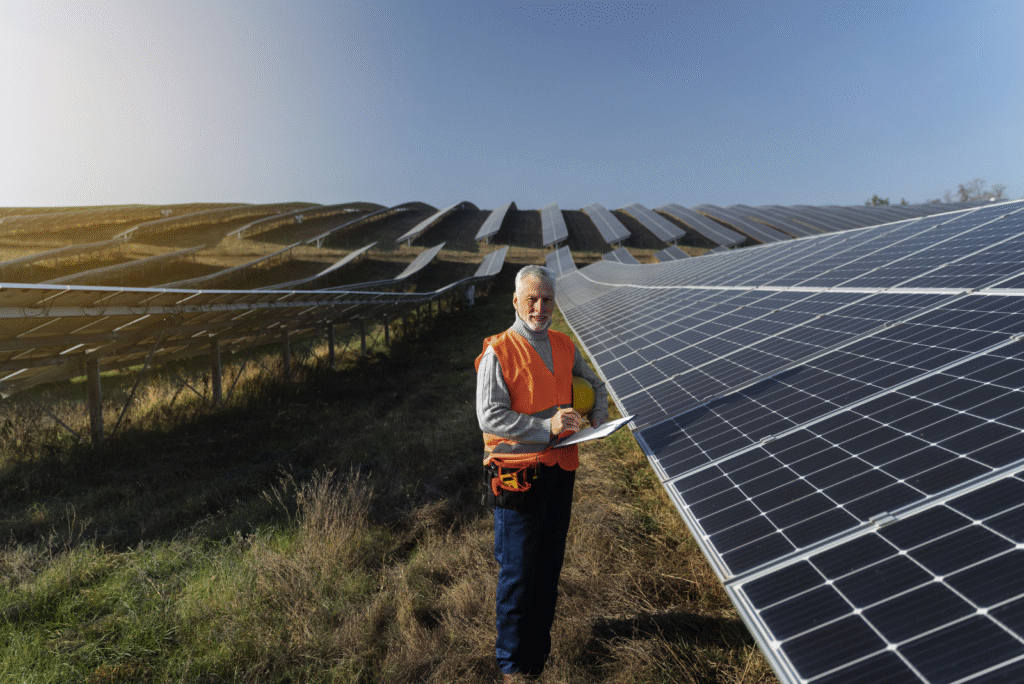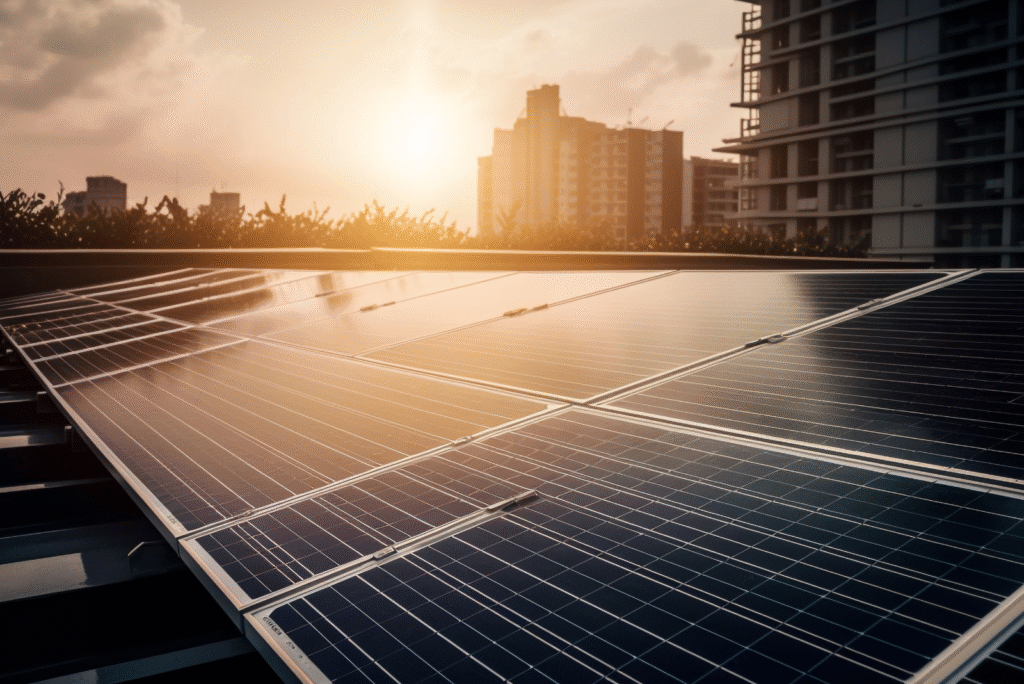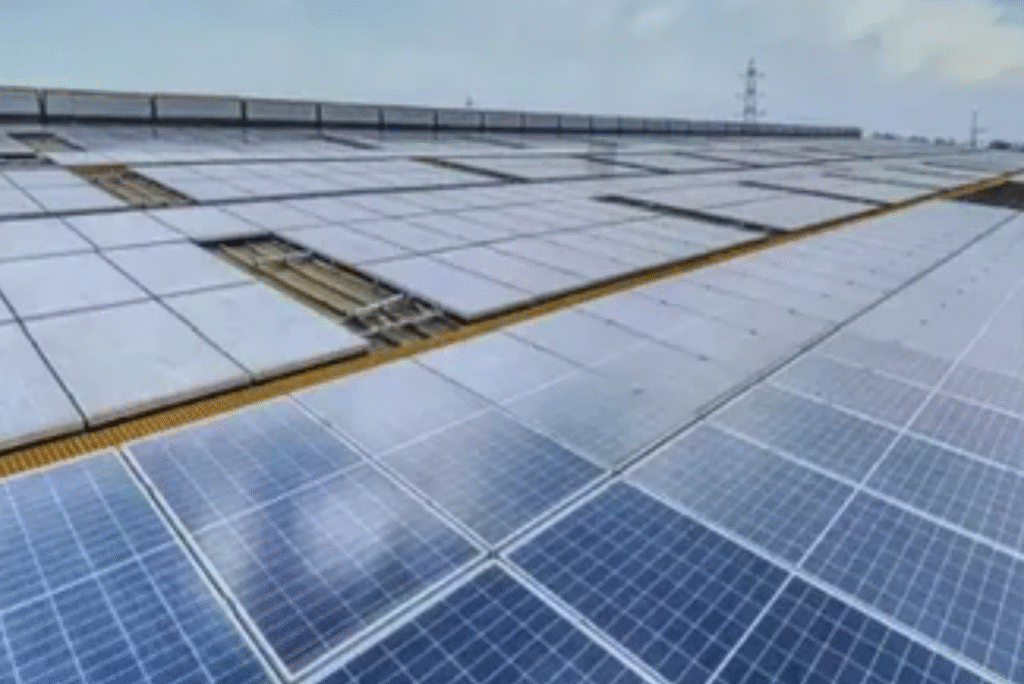Types Of Solar Energy

Types Of Solar Energy Home Blogs With the world rapidly changing, interest in renewable resources is growing more and more. There are different ways people are turning to help themselves as well as the environment. Solar Energy is one of those beneficial ways out of the never-ending vicious cycle of using depleting energy sources. The Sun being a vital source of renewable energy offers sustainable and environmentally friendly alternatives to fossil fuels. Knowing the different types of solar energy serves to inform people of the best options available to them for the accurate utilization of this priceless resource. So what actually is solar energy? Solar energy is the radiation from the sun responsible for generating heat and electricity. The ever-evolving technologies present harness this energy for different purposes which include generating electricity, for commercial or industrial use and in daily life. Different Types of Solar Energy Exploring the types of solar energy enables one to determine the best choice for electricity needs, heating, or even energy storage, thus making the use of solar power a strategically beneficial investment for the clean future. Solar Photovoltaic (PV) Energy Solar energy is trapped through photovoltaic (PV) cells or solar thermal collectors. These PV cells help in converting sunlight directly into electricity. When sun rays fall on the cells, it creates a flow of electric current. You will commonly find this technology in solar panels installed in places using up solar energy like rooftops or farms. Solar Thermal Energy Another way of making good use of solar radiation is through Solar thermal technology. It involves trapping and concentrating sunlight to generate heat. This heat is then further used for heating purposes or converted into electricity. This further divided into two types High-Temperature Solar Thermal: You will generally find the use of them in large-scale power plants to generate electricity. Low-Temperature Solar Thermal: These are often used in places like homes or buildings for small tasks like heating water or generating electricity for lamps. Concentrated Solar Power Mirrors like a plane and parabolic mirrors are arranged to achieve the directing and converging of sun rays. Lenses like Converse lenses are also used. The mirror will force the rays to a receiver which in turn heats a fluid. The steam obtained is used to drive turbines producing energy. The best part of it is that it can store the heat energy for cloudy days or nighttime. Passive Solar Energy This refers to the use of sun rays directly to heat the required surface without incorporating any technologies or mechanical systems. The innovative architecture and design itself suffice for the tapping of heat energy. Buildings and places are designed in a way they absorb and are exposed to plenty of sunlight. This involves the use of glass facing the sun to absorb heat or other thermal materials. Hybrid Solar Energy As the name suggests, hybrid solar energy mixes two or more types of the above-mentioned solar energy systems to create the best-suited one for you. For example, concentrated solar energy is often merged with others to increase productivity or customise a system that best caters to needs. Applications of Solar Energy Solar energy is the need of the hour. It’s helpful to overcome issues of global warming to a large extent. This concept can be applied varyingly. The applications of solar power are broad and adaptable which makes it easily usable across various areas of a home, business, or manufacturing facility. 1. Due to solar energy electricity is generated which is vital in today’s world. This energy is used to power small houses or organisations. 2. Solar energy has been adapted to be used for running appliances like solar cookers, solar geysers, etc. Assists in water heating and ventilation. 3. Solar lighting can be used not only for homes but factories, offices, street lights, etc. Solar-powered pumps can be used by farmers to pump water in their fields. 4. Solar energy can be stored in batteries to add the advantage of portability and make it accessible despite odd hours and places. 5. Solar energy used as a solar furnace is good enough to operate industrial work of melting metals, producing energy at a large scale. Air conditioners can also be powered with this. 6. Solar energy can be used to charge electric vehicles, safeguarding the environment. Solar power can be used to power big generators. 7. From the smallest tasks like charging phones to driving big-scale turbines for power synthesis, solar energy can meet most of the ends. Benefits of Solar Energy Renewable and Abundant Due to the sun being the source, the energy supply is inexhaustible. It is abundant and you won’t run out of it as long as the earth has the sun shining. Easily Accessible As the sun shines almost everywhere on this planet, solar energy is easy to access. Especially in remote areas where it might be difficult to get other means of development, the sun is always a good option to consider. Environmentally Friendly Solar energy does not lead to the emission of harmful gases or pollutants which helps reduce carbon footprint. Solar energy is a better alternative to the depleting resources which cause harm to the environment. Economic Benefits Manpower is needed for projects so when it comes to setting up these big solar power plants people are needed. All of this provides job opportunities to people. Independent Source Solar energy is sufficient on its own to operate the desired system. It doesn’t rely on other energy sources, hence retaining its renewable and eco-friendly features. Cost-effective Investment in solar energy is a one-time golden decision. Apart from the initial costs, maintenance and repairs don’t cost much yearly. Government subsidies are available for solar panel installation and choosing this also reduces your electricity bill. Diverse Usage Solar energy can be creatively employed in small domestic as well as corporate units to perform various tasks. This makes it not confined to just one or two applications. Conclusion KLK Ventures is the go-to place for your solar installations.
Solar Constant

Solar Constant Home Blogs Utilising non-conventional sources of energy is made simple in our advancing world with the use of innovative technology but it surely is a fairly complex science. Solar energy uses and processes the sun’s power to harness usable energy forms. The rays of the sun carry along with them the required radiation which gets converted to other types of energy. Every sun ray carries some amount of electromagnetic radiation in it. At KLK Ventures the solar services that are provided are well versed in solar panels that make use of solar radiation phenomena and the solar constant as utilized in the solar panel business. t’s crucial to understand the workings of this energy-producing process. Hence, for those interested in adopting this clean and green renewable source, it becomes even more important to know the estimated solar radiation that will be received. Solar Constant becomes a good way to explain this scientific phenomenon. Understanding the term Solar Constant Solar constant in simple terms is the amount of solar energy a given piece of area is receiving at a distance of 1 Astronomical Unit (roughly the distance from sun to Earth, i.e. the distance that ray will travel to reach our green planet) from the sun. The factors of area and time are also often considered. The rays of the sun or light for that matter, depict both electrical and magnetic properties. Since solar rays are carriers of electromagnetic radiation, essentially what solar constant is measuring is the flux density of these radiations, the Flux being anything that passes through a surface and its concentration when measured is the flux density. The solar constant is often denoted by the notation of GSC. However, unlike what we all think by hearing the word “constant”, it isn’t exactly true for this case. Unlike the constants used in physics or maths, it is more like an average of values. These values measured at different times of the year give slightly different results because the distance from the sun doesn’t remain fixed throughout. The current average value of the solar Constant is 1.361 kilowatts per square metre at the solar minimum and 1.362 kilowatts per square metre at the solar maximum. Since our environment at Earth’s surface is affected by factors like air resistance, the solar Constant is measured generally by the satellites orbiting our planet. Variation in Solar Constant: The value of the solar constant experiences a slight variation in its measurement contrary to it otherwise being named ‘constant’. However, the variation is something of a natural phenomenon that takes place because of the two major bodies that are involved in the process: the Sun and the Earth. That being the more simplified version of putting the variation forward, however, it depends on certain features of the two bodies involved- the sun’s luminosity besides the distance between the two bodies and the earth’s distinct rotation around the sun. Both these points can be understood as explained below: How does the Sun’s Luminosity cause variation in the value of the solar constant? The sun’s luminosity is presented to be 3.86 x 10^26 watts however only some of this is captured by the earth’s surface that comes to the equal of 0.000000045%. The energy that is utilised in the solar energy capturing and harvesting process approximates 1370 watts per square metre of the earth’s surface. The distance between the two bodies contributes to this difference. Another smaller variation that comes into play is in the total luminosity of the sun which is believed by various researchers to have changed by about 1% in the past 30 years. The variation has been measured abroad using radiometers over the years through numerous satellites. The power yield of the sun’s energy is believed to be varying which affects the solar constant over vast gap years as it is believed to be increasing 10% every billion years. How Does Earth’s Orbit Affect Variation in Solar Constant? As generally all are aware the Earth is present in the solar system at a slight tilt in its centre that changes over time, along with this tilt the consequential factor is the characteristic elliptical orbit that the Earth performs around the sun. The solar constant’s value varies -+3% because of the elliptical orbit of the earth. The distance of the earth also varies in this factor as when in January’s first week the distance is lesser and smaller and the distance is larger in July’s first week affects the solar radiation received during these times. How does Solar Constant Become Important? The solar constant is generally important for all individuals conscious about the environmental health of the planet as it measures the solar radiation and is an important factor that affects the climate of the planet. KLK ventures thus provide a green and resourceful installation of solar solutions to minimize any harm to the environment. A solar Constant proves of value for measuring the quantity of radiation that will reach the earth’s surface. In easy words, it’s the rate of electromagnetic radiation available in 1 square metre of surfaces like solar panels. It provides us with the intensity of energy received as raw material to our device per second. As stated above, the power of the sun that we have with us to process is close to 1360 watts per metre square per second. It proves to be of importance for solar panel devices as one can be sure of the amount and value of solar energy that is captured and we at KLK Ventures facilitate solar solution installations that efficiently utilize these phenomena in its solar panel business. Apart from solar panels, it can also be used to calculate radiation pressure. It is an important value for worldwide energy equilibrium and climate and temperature changes. Solar constant is thus an important element in the whole process of coming to understand solar energy and its usage. It is a value that makes one aware of the fundamental feature of
What is a Solar Pump?

What is a Solar Pump? Home Blogs Why Should We Use Solar Water Pump? Solar Water Pump is an environmentally friendly solution to our current problems. Sustainability is critical in this modern world and needless to say, energy is been wasted at an unforgiving rate. To tackle this issue, humanity has developed the best way to capture solar energy which is both effective and environmentally safe. A solar pump is a device that relies solely on the Sun’s supply of energy in order to operate and for some places where accessing electric power is an issue this can turn out to be the most reliable and useful device. One of the greatest achievements in agricultural development is the utilization of the electric water pump that now has the ability to operate on the energy provided by the sun’s radiation. We at KLK together bear the responsibility of adding to this vision and help towards achieving a better and greener planet by functioning towards a sole goal of providing solar full-service in the near future. How Does a Solar Water Pump Work? A solar water pump works on the theory of energy conversion and electricity generation and water pumping through the use of suns energy. This effective and efficient device consists of three main components. Solar Panels A crucial component of solar PV arrays commonly referred to as solar panels, these devices receive solar power and convert it through photovoltaic cells into electricity. Pumping System A motor can be directly coupled or battery coupled depending on the application of the device, where the PV is directly connected to the pump or where the PV is connected to a storage battery. The two types of motors that respond to the device’s application are AC for the alternating current and DC for the direct current. Pump Controller The controllers are those which control the operation of the tanks, the water pumps and the tanks as well as the structures for mounting or installing. At KLK, the meri is placed on the customer by offering a complete package including panel installation, maintenance, and consultations on energy efficiency. The technology is more easy to embrace because they do not have to worry on the engineering or device complexities. Solar Pump Types You will find various types of solar pumps available. Some of these are: Submersible Solar Pumps Submersible solar pumps are specially designed to be submerged underwater as they are deployed to great depths to lift water from underground sources. In comparison to other pumps, these are much more efficient as they are able to lift more water with an AC or DC power source with relatively lesser energy requirements. Surface Solar Pumps These pumps have similar functions to Submersible Pumps and their use is for drawing water, only the source being used for drawing water is different. In this case, the source is oceans and rivers, and the pumps are mounted on the surface allowing them to pull from sources that are relatively shallow. Used for small scale endeavors like irrigation of fields, pumping water for personal use or for animals. They also come in both AC and DC varieties. Although they require a much lower installation cost, they offer a lower utilization cost and have a higher discharge capacity. Applications of Solar Water Pumps Surface Solar Pumps Solar water pumps can provide a tremendous service in a wide array of activities, for instance: Agriculture With irrigation and other activities in need of water, they are efficiently able to supply agriculture as needed. In this regard, KLK provides the best commercial solar solutions. Rural Areas In places where electricity is not available for more than 24 hours, water pumps that use solar energy ensure a plentiful supply of water at all times of the day. Domestic Chores In tasks such as gardening or managing water in personal homes, they can provide a practical and environmentally friendly solution at a low cost. Livestock Watering They offer ample water supply for livestock in economically challenging rural and agriculturally rich regions. Clean Drinking Water Solar Water Pumps are important, they help offer clean potable water to impoverished regions found in rural areas. Benefits of Solar Water Pumps Besides them being efficient and environment-friendly, solar water pumps can bring about other advantages too: Energy Efficiency They make use of solar energy and in doing so, they end up using less energy than the other variants do. Eco-friendly As a type of energy that is non conventional, they present little or no danger to the environment. Cost-effective There is no denying that solar energy literally has no cost, which can in turn help reduce the expense per individual. KLK Ventures provide cost-effective options. Ease of Use One wow factor that stands out are these pumps, they are very effective and simple to use. Low Maintenance Maintenance for these systems is cheap and not that time consuming, ensuring sustainability for the long term. With KLK Ventures, you can benefit from annual maintenance contracts, or simply get the right advice and later decide what to do. Local Water Bodies These systems are much easier to implement in rural areas which use local resources such as a river, lake, and well. Government Support Different policies help in the installation of solar powered pumps to those capable of meeting set requirements. Conclusion Solar water pumps are the best option for providing water in the future because they use technology that is friendly to the environment and is powered by the sun. It is common in the modern world to utilize energy supplied through solar because it is important in saving energy and finds a better solution for all. KLK comes to aid—if you are a businessman, an agriculturalist needing a dependable source of water, or even a regular person who wishes to be a responsible citizen. We offer a variety of solar panel installation services, both grid tied and off-grid that serve as an incentive to the use of solar powered water pumps. This assists entrepreneurs in environmentally friendly
